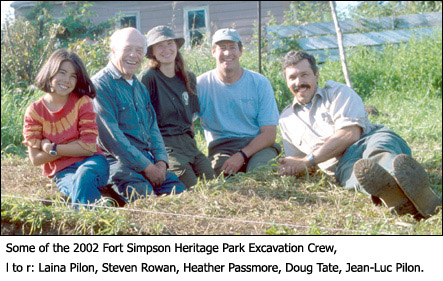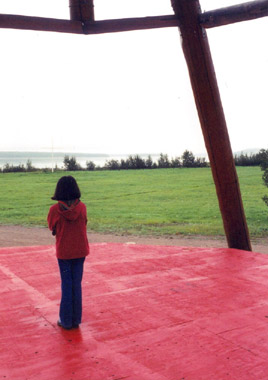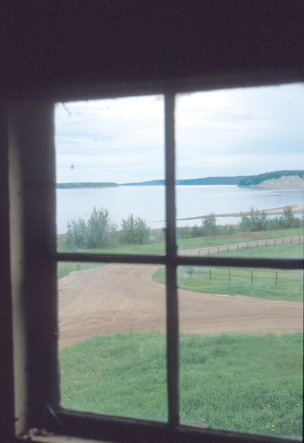

 During the
summer of 2002, my daughter Laina and I were very aware that
somewhere
near
the Fort Simpson Heritage Park were the mortal remains of
François Pilon and his friends who had died of starvation in
March of 1811. We found no evidence of these burials in our
archaeological investigations during that summer, yet we were certain
they were nearby. To learn more about our research, follow
this link for the
2002 work & 2003
work. During the
summer of 2002, my daughter Laina and I were very aware that
somewhere
near
the Fort Simpson Heritage Park were the mortal remains of
François Pilon and his friends who had died of starvation in
March of 1811. We found no evidence of these burials in our
archaeological investigations during that summer, yet we were certain
they were nearby. To learn more about our research, follow
this link for the
2002 work & 2003
work.François had lived out his final days within a few dozen meters of the location where his holiness Pope John Paul II said mass in 1987 with representatives of Canada's First Nations, a truly remarkable event. Could François have ever of conceived of such a thing happening? Never.  Nor could he ever have believed that relatives of his would
one day be so close to his long forgotten and lonely tomb, praying for
him, for the rest of his soul, expressing the kinds of sentiments which
emerge at graveside during a burial, feelings that his family would
have liked to have been able to share with his neighbours and
friends. But his family probably only heard of his death years
afterwards when this news was already old news. Nor could he ever have believed that relatives of his would
one day be so close to his long forgotten and lonely tomb, praying for
him, for the rest of his soul, expressing the kinds of sentiments which
emerge at graveside during a burial, feelings that his family would
have liked to have been able to share with his neighbours and
friends. But his family probably only heard of his death years
afterwards when this news was already old news.And so, before leaving Fort Simpson, we stood quietly on the huge platform which overlooks the Papal Flats, where a pope had once stood, and we quietly prayed for our lost relative. We were certainly the first members of his family to ever ponder his fate so close to where he lay. From this platform we had a beautiful view of the mouth of the Liard River, of the promontory there still called by the French name Gros Cap, and e  ven
further up the Mackenzie River. Without being aware of it,
our gaze was directed over thousands of kilometers seeing once again
the Island of Montréal, perhaps Pierrefonds or Les
Cèdres. For a brief moment we could feel the futile hope
that François must have felt during his last days or was that
simply despair? Had he dreamed to the point of delirium of
hearing familiar voices, of smelling the wonderful aromas rising from
his mother's cooking pots, of feeling the warm breeze rising off the
waters of the mighty St. Lawrence river as it passed in front of his
ancestral home to the sounds of children playing games their ancestors
had brought over from the old country, from France generations
before? Had he
traveled one last time, in his mind at least, through that endlessly
long trip that had brought him to the Forks of the Mackenzie, perhaps
starting in front of a notary, making his mark on a contract with
MacTavish, Frobisher & Co. in 1803, spending his first winter at
Grand Portage on Lake Superior, learning all kinds of news phrases in
the Objibwa language and trading for warm moose skin clothing from his
new friends. Had he sung, for the hundredth time, those old voyageur songs created
as much to keep the rhythm of the paddle as to
preoccupy sad and suffering hearts? These were just some of the
questions and images that went through our minds. For a moment,
it was François Pilon who gave us answers. For a moment,
ever so briefly, François smiled at us, warmed by the fact that
tears had washed the earth in which he lay and that finally, his rest
could begin. ven
further up the Mackenzie River. Without being aware of it,
our gaze was directed over thousands of kilometers seeing once again
the Island of Montréal, perhaps Pierrefonds or Les
Cèdres. For a brief moment we could feel the futile hope
that François must have felt during his last days or was that
simply despair? Had he dreamed to the point of delirium of
hearing familiar voices, of smelling the wonderful aromas rising from
his mother's cooking pots, of feeling the warm breeze rising off the
waters of the mighty St. Lawrence river as it passed in front of his
ancestral home to the sounds of children playing games their ancestors
had brought over from the old country, from France generations
before? Had he
traveled one last time, in his mind at least, through that endlessly
long trip that had brought him to the Forks of the Mackenzie, perhaps
starting in front of a notary, making his mark on a contract with
MacTavish, Frobisher & Co. in 1803, spending his first winter at
Grand Portage on Lake Superior, learning all kinds of news phrases in
the Objibwa language and trading for warm moose skin clothing from his
new friends. Had he sung, for the hundredth time, those old voyageur songs created
as much to keep the rhythm of the paddle as to
preoccupy sad and suffering hearts? These were just some of the
questions and images that went through our minds. For a moment,
it was François Pilon who gave us answers. For a moment,
ever so briefly, François smiled at us, warmed by the fact that
tears had washed the earth in which he lay and that finally, his rest
could begin. |
| Back to the Introduction |
Who was this François Pilon? |